

Chemistry. What It's Like on the Inside: Proficiency Scales: What Lies Beneath. In my last post, I shared a bit about a new frontier with proficiency scales as an evaluation tool.
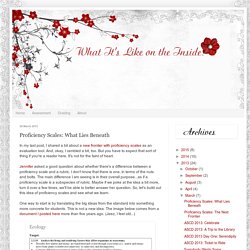
And, okay, I rambled a bit, too. But you have to expect that sort of thing if you're a reader here. It's not for the faint of heart. What It's Like on the Inside: Tools for Biology Review. The regs here know that I've been thinking about and working on (and implementing) a plan to do some last-ditch remediation for my biology students.
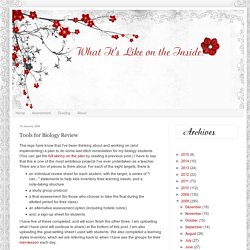
(You can get the full skinny on the plan by reading a previous post.) I have to say that this is one of the most ambitious projects I've ever undertaken as a teacher. There are a ton of pieces to think about. For each of the eight targets, there isan individual review sheet for each student, with the target, a series of "I can... " statements to help kids inventory their learning needs, and a note-taking structurea study group protocola final assessment (for those who choose to take the final during the allotted period for their class)an alternative assessment option (including holistic rubric)and, a sign-up sheet for students.I have five of these completed, and will soon finish the other three.
I am uploading what I have (and will continue to share) at the bottom of this post. Enjoy! Results of a unit long experiment in SBG and flipping. I've been a believer in the concept of standards based instruction for a while.
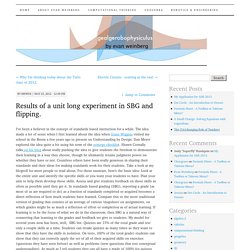
The idea made a lot of sense when I first learned about the idea when Grant Wiggins visited my school in the Bronx a few years ago to present on Understanding by Design. Dan Meyer explored the idea quite a bit using his term of the concept checklist. Shawn Cornally talks on his blog about really pushing the idea to give students the freedom to demonstrate their learning in a way they choose, though he ultimately retains judgment power on whether they have or not.
Countless others have been really generous in sharing their standards and their ideas for making standards work for their students. Take a look at my blogroll for more people to read about. Geometry I started the unit by defining the seven skills I wanted the students to have by the end on this page. I quickly ran into the logistical nightmare of managing the paperwork and recording assessment results. Algebra 2 Warning: some philosophizing ahead. Mrs. E's Scoring System. Scoring System FAQ - Mrs. E's Biology Site. Why aren’t there assignment names or tasks like “Quiz” or “Test” in your gradebook?
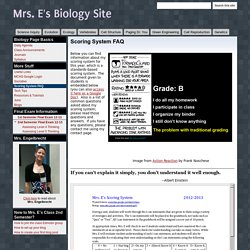
What you will see in my gradebook is the I can statements we are studying in each unit. For example, for Ecology, you will see tasks such as “Ecology Objective #1b” or “Ecology Objective #4d.” The reason the actual I can statement is not written in the gradebook is because the gradebook program we currently use limits the length of a task name. If you are curious as to what the specific I can statement is, you can look that up on the class website. Click on “I can statements” in the menu tab, and then click on the appropriate file on that page. Why are you setting up your gradebook so differently? The reason for setting up my gradebook in this manner is so students can focus on the skills and content that are required of them to master in the course, rather than on accumulating and collecting points to get a letter on a piece of paper at the end of the semester.
SBG Implementation: Topic Scales. For those of you not active in the twitterverse, among the people I follow there's been an increasing interest in standards-based grading.
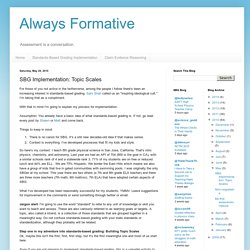
SamShah called us an "inspiring ideological cult. " I'm taking that as a compliment. With that in mind I'm going to explain my process for implementation. Assumption: You already have a basic idea of what standards-based grading is. If not, go read every post by Shawn or Matt and come back. Things to keep in mind: There is no canon for SBG. What I've developed has been reasonably successful for my students, YMMV. Jargon alert: I'm going to use the word "standard" to refer to any unit of knowledge or skill you want to teach and assess.
Step one in my adventure into standards-based grading: Building Topic Scales Ok, maybe this isn't the first, first, first step, but it's the first meaningful one and most of us start here. Even if you are not planning to implement standards-based grading, this is a valuable activity to do. Marzano%E2%80%99s 4-Point Rating Scale.pdf. Conjunctive Standards-Based Grading. I’ve had a lot of requests lately to explain my grading system, so I thought I would outline it in as much detail as possible here.

I learned this summer that what I do is apparently called “conjunctive scoring”. That is, students cannot compensate for a low score in one area (say, their understanding of forces) with a high score in another area (say, conservation of energy). Rather, it requires at least a minimum amount of mastery in every area to earn a passing grade overall. A minimum amount of mastery? My physics objectives are split into “A” and “B” flavors. Even if a student has shown mastery on some B’s, if they are missing an A objective, they are not yet in a position to earn a passing grade at the end of the term. How I grade assessments: Yes/No and Feedback A scanned copy of a grading sheet from last year. First, I work through every test, marking them up with comments, corrects, etc. The markings that I use: